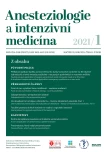A rare complication of central venous catheter insertion
Authors:
T. Bělohlávek 1; V. Zoľák 1; J. Köppl 2; S. Nosáľ 1
Authors‘ workplace:
Klinika detskej anestéziológie a intenzívnej medicíny Univerzitná nemocnica Martin, Jesseniova lekárska fakulta v Martine, Univerzita Komenského v Bratislave
1; Detská klinika anestéziológie a intenzívnej medicíny LF UK, LF SZU a NÚDCH, Bratislava
2
Published in:
Anest. intenziv. Med., 32, 2021, č. 1, s. 44-47
Category:
Case Reports
Overview
The insertion of a central venous catheter is an integral part of the therapy and monitoring of critically ill patients in intensive care units. Although, ultrasonography significantly improves the success and safety of insertion, it is still invasive procedure associated with the risk of many complications. Rare, later complications include migration – leaving the end of initially in the correct position inserted catheter. The exact mechanism of migration is unknown. In the present text, we describe a case of rare migration of a central venous catheter inserted through the right internal jugular vein originally into the right heart atrium back to the right internal jugular vein in a 4,5-year-old girl with polytrauma.
Keywords:
central venous catheter – complications – migration of the catheter – internal jugular vein
Sources
1. Meyer JA. Werner Forssmann and catheterization of the heart, 1929. Ann Thorac Surg. 1990 Mar; 49(3): 497–499. doi: 10.1016/0003-4975(90)90272-8
2. Seldinger SI. Catheter replacement of the needle in percutaneous arteriography; a new technique. Acta radiol. 1953 May; 39(5): 368–376. doi: 10.3109/00016925309136722
3. Higgs ZCJ, Macafee DAL, Braithwaite BD, Maxwell‑Armstrong CA. The Seldinger technique: 50 years on. Lancet 2005 Oct; 366(9494): 1407–1409. doi: 10.1016/S0140-6736(05)- 66878-X
4. American Society of Anesthesiologists Task Force on Central Venous Access; Rupp SM, Apfelbaum JL, Blitt C, Caplan RA, Connis RT, Domino KB, et al. Practice guidelines for central venous access: a report by the American Society of Anesthesiologists Task Force on Central Venous Access. Anesthesiology 2012 Mar; 116(3): 539–573. doi: 10.1097/ ALN.0b013e31823c9569
5. Kolikof J, Peterson K, Baker AM. Central Venous Catheter, StatPearls [on‑ line]. 2020 Jan, PMID: 32491730, Bookshelf ID: NBK557798
6. Jamshidi R. Central venous catheters: Indications, techniques, and complications. Semin Pediatr Surg. 2019 Feb; 28(1): 26–32. doi: 10.1053/j.sempedsurg.2019. 01. 005
7. Kornbau C, Lee KC, Hughes GD, Firstenberg MS. Central line complications. Int J Crit Illn Inj Sci. 2015; 5(3): 170–178. doi: 10.4103/2229-5151.164940
8. Smit JM, Raadsen R, Blans MJ, Petjak M, VandeVen PM, Tuinman PR. Bedside ultrasound to detect central venous catheter misplacement and associated iatrogenic complications: a systematic review and meta‑analysis. Crit Care. 2018 Mar; 22(1): 65. doi: 10.1186/ s13054-018-1989-x
9. Hind D, Calvert N, McWilliams R, Davidson A, Paisley S, Beverley C, et al. Ultrasonic locating devices for central venous cannulation: meta‑analysis. BMJ. 2003; 327(7411): 361. doi: 10.1136/bmj.327.7411.361
10. Froehlich CD, Rigby MR, Rosenberg ES, Li R, Roerig PLJ, Easley KA, et al. Ultrasound‑guided central venous catheter placement decreases complications and decreases placement attempts compared with the landmark technique in patients in a pediatric intensive care unit. Crit Care Med. 2009 Mar; 37(3): 1090–1096. doi: 10.1097/CCM.0b013e31819b570e
11. Ambesh SP, Pandey JC, Dubey PK. Internal Jugular Vein Occlusion Test for Rapid Diagnosis of Misplaced Subclavian Vein Catheter into the Internal Jugular Vein. Anesthesiology. 2001; 95(6): 1377–1379. doi: 10.1097/00000542-200112000-00016
12. Schummer W, Schummer C, Rose N, Niesen WF, Sakka SG. Mechanical complications and malpositions of central venous cannulations by experienced operators. A prospective study of 1794 catheterizations in critically ill patients. Intensive Care Med. 2007 Jun; 33(6): 1055–1059. doi: 10.1007/s00134-007-0560-z
13. Prabaharan B, Thomas S. Spontaneous migration of central venous catheter tip following extubation. Saudi J Anaesth. 2014; 8(1): 131–133. doi: 10.4103/1658-354X.125975
14. Wu PY, Yeh YC, Huang CH, Lau HP, Yeh HM. Spontaneous migration of a Port‑a- Cath catheter into ipsilateral jugular vein in two patients with severe cough. Ann Vasc Surg. 2005 Sep; 19(5): 734–736. doi: 10.1007/s10016-005-4638-1
15. Roblin D, Porter JC, Knight RK. Spontaneous migration of totally implanted venous catheter systems from subclavian into jugular veins. Thorax. 1994 Mar; 49(3): 281–282.
16. Jabeen S, Murtaza G, Hanif MZ, Morabito A, Khalil B. Migration of Indwelling Central Venous Catheter and Fatal Hydrothorax. European J Pediatr Surg Rep. 2014 Jun; 2(1): 32– 34. doi: 10.1055/s-0033-1347130
17. Yeh CM, Chou CM. Spontaneous Migration of Central Venous Catheter to Anterior Mediastinum. Trends Journal of Sciences Research. 2018; 3(4): 147–150. https://doi. org/10.31586/Surgery.0304.01
18. Wu CY, Fu JY, Feng PH, Liu YH, Wu CF, Kao TC, et al. Risk factors and possible mechanisms of intravenous port catheter migration. Eur J Vasc Endovasc Surg. 2012; 44(1): 82–87.
19. Kock HJ, Pietsch M, Krause U, Wilke H, Eigler FW. Implantable vascular Access systems: experience in 1500 patients with totally implanted central venous port systems. World J Surg. 1998 Jan; 22(1): 12–16. doi: 10.1007/s002689900342
Labels
Anaesthesiology, Resuscitation and Inten Intensive Care MedicineArticle was published in
Anaesthesiology and Intensive Care Medicine

2021 Issue 1
Most read in this issue
- Doporučení pro anestezii a sedaci u kojících žen
-
Point of care examination of blood clotting –
current possibilities - Ketamin – nezávislost disociativní a analgetické působnosti
- Fascial planes for regional anesthesia of the lower limb
